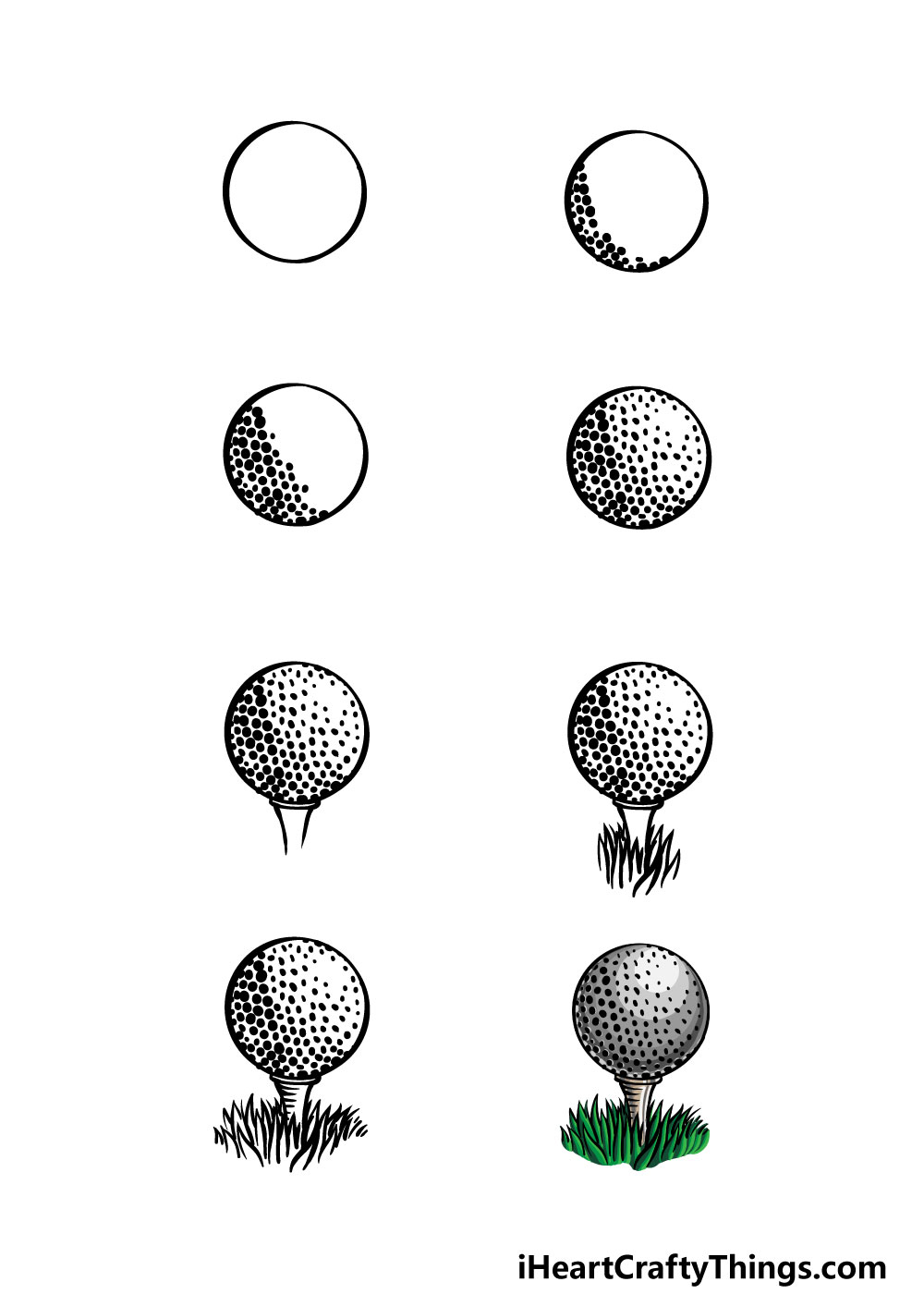To draw a golf ball, start with a perfect circle. Add small, evenly spaced dimples inside the circle.
Drawing a golf ball may seem challenging, but it’s simple with the right steps. Golf balls have distinct features, including symmetrical dimples that affect their flight. Begin by sketching a perfect circle, ensuring it’s round and smooth. Next, focus on the dimples, which give the ball its unique texture.
Use light, consistent strokes to add these small indentations, making sure they are evenly spaced. Pay attention to the size and placement of each dimple for accuracy. Practice will help you achieve a more realistic look. By following these steps, anyone can create a detailed and accurate drawing of a golf ball.
Introduction To Golf Ball Drawing
Learning to draw a golf ball can be fun and rewarding. It helps golfers improve their game. Drawing a golf ball involves understanding the basics and practicing often. This section will guide you through the importance of drawing techniques and the benefits for golfers.
Importance Of Drawing Techniques
Drawing a golf ball correctly is essential. It helps in visualizing shots better. This visualization improves accuracy and control. Here are some key techniques:
- Grip: Hold the club with the correct grip for better control.
- Stance: Keep a balanced stance to ensure a stable swing.
- Backswing: Maintain a smooth backswing to set up a powerful shot.
- Follow-through: Complete your swing with a proper follow-through.
Practicing these techniques regularly helps in mastering the art of drawing a golf ball.
Benefits For Golfers
Understanding how to draw a golf ball offers several benefits. Some of these benefits include:
- Improved shot accuracy.
- Better control over the ball’s direction.
- Enhanced confidence on the course.
- Increased enjoyment of the game.
Golfers who master these skills often see improved performance. They can navigate courses more effectively. This leads to lower scores and greater satisfaction.
Essential Drawing Materials
Drawing a golf ball requires the right materials. Quality tools make your drawing better and easier. Let’s explore the essential materials needed for drawing a golf ball.
Choosing The Right Pencils
Pencils are key to a successful drawing. Different pencils create different effects. Use a 2H pencil for light lines. For darker lines, a 2B pencil is ideal.
| Pencil Type | Usage |
|---|---|
| 2H | Light lines |
| HB | General drawing |
| 2B | Dark lines and shading |
Selecting Paper And Erasers
Paper should be smooth and strong. A good choice is Bristol paper. It holds the pencil well and is durable.
Erasers are crucial for clean drawings. Use a kneaded eraser for soft corrections. A vinyl eraser is good for strong erasing.
- Bristol paper – Smooth and durable
- Kneaded eraser – Soft corrections
- Vinyl eraser – Strong erasing
Basic Shape And Proportions
Drawing a golf ball can seem challenging. Start with the basic shape and proportions. This guide will help you understand how to create a realistic golf ball. Learn how to draw the circle and establish proportions.
Drawing The Circle
First, draw a perfect circle. Use a compass or a round object. Make sure the circle is smooth and even. The circle forms the base of your golf ball.
Try to keep the circle’s size consistent. This step is crucial for the golf ball’s look.
Establishing Proportions
Now, focus on the ball’s dimples. These small, round marks cover the surface. Start by drawing light grid lines. These lines will guide you.
- Divide the circle into equal sections.
- Mark where the dimples will go.
Keep the dimples evenly spaced. Consistent spacing makes the drawing look real. Each dimple should be the same size. This step enhances the golf ball’s texture.
Follow these steps to ensure accurate proportions. Use light strokes for easy adjustments. This way, you can correct mistakes quickly.

Credit: iheartcraftythings.com
Adding Dimples To The Ball
Adding dimples to a golf ball is essential for realism. Dimples affect the ball’s flight and appearance. Let’s explore how to add them perfectly.
Understanding Dimple Patterns
Golf balls have different dimple patterns. Each pattern affects the ball’s behavior. To draw these, you need to understand their arrangement. Dimples are usually circular and evenly spaced. Some balls have hexagonal patterns. You can start by drawing small circles. Ensure they are evenly distributed.
Creating Depth With Shadows
Shadows add depth to your dimples. Without shadows, the ball looks flat. Draw tiny shadows on one side of each dimple. This creates a three-dimensional effect. Use a soft pencil or light shading. Make sure the shadows are consistent. This means they should all be on the same side.
| Step | Description |
|---|---|
| 1 | Draw small, evenly spaced circles. |
| 2 | Ensure circles follow a consistent pattern. |
| 3 | Add shadows to one side of each dimple. |
- Use a soft pencil: It helps with shading.
- Draw lightly: Heavy lines make erasing difficult.
- Consistent shadows: Ensure they are all on the same side.
- Draw the outline of the golf ball.
- Add small circles for dimples.
- Shade one side of each dimple for depth.
Practice makes perfect. Keep drawing and improving. Soon, your golf balls will look realistic.
Shading Techniques
Drawing a golf ball can be a rewarding challenge. Shading techniques bring your drawing to life. Let’s dive into some essential shading methods.
Light Source And Shadows
Identify your light source first. This defines where shadows fall on the golf ball. Use a single light source for simplicity. Draw a small circle to mark the light source direction.
Next, shade the opposite side of the ball. The shaded area should be darkest farthest from the light source. This creates a three-dimensional effect. Use a soft pencil for shading.
Blending For Realism
Blending is key to realistic shading. Use a blending stump or tissue for smooth transitions. Start with the darkest areas first. Gradually blend towards the light source.
Apply light pressure for soft shadows. This helps in creating a natural look. Keep the strokes consistent and even.
| Technique | Description |
|---|---|
| Hatching | Parallel lines for shading. |
| Cross-Hatching | Intersecting lines for deeper shadows. |
| Stippling | Dots for texture and shade. |
Remember to keep practicing. Each drawing will improve your skills. Soon, your golf balls will look incredibly realistic.
Detailing The Golf Ball
Creating a realistic golf ball drawing requires attention to detail. Each element of the golf ball plays a key role. Let’s dive into refining the dimples and enhancing the texture.
Refining The Dimples
Golf balls have unique dimples. These dimples help the ball fly smoothly. To draw them accurately, follow these steps:
- Sketch the Outline: Draw a circle to represent the ball.
- Grid Lines: Lightly draw horizontal and vertical lines. This helps in placing the dimples evenly.
- Placement: Draw small circles for the dimples. Make sure they are evenly spaced.
- Depth: Add shading to create depth. This makes the dimples look real.
Enhancing Texture
The texture of a golf ball adds to its realism. Here’s how you can enhance it:
- Surface Shading: Use light and dark shades. This gives the ball a three-dimensional look.
- Highlighting: Add highlights to the raised areas. This enhances the texture.
- Blending: Blend the shades smoothly. This makes the ball look polished.
Follow these steps to detail a golf ball. Your drawing will look realistic and detailed.
Final Touches
Adding the final touches to your golf ball drawing is crucial. These details make your drawing realistic and polished. Focus on checking for consistency and final shading and highlights. Each step enhances the drawing’s depth and texture.
Checking For Consistency
Consistency ensures your drawing looks balanced. Check the size and shape of the dimples. They should be evenly spaced and similar in size. Use a ruler or grid if needed. This helps maintain uniformity throughout your drawing. Review your lines and curves. Adjust any irregular shapes or lines.
Final Shading And Highlights
Shading adds depth and realism. Use a light source to decide where shadows fall. Apply light pencil strokes for softer shadows. Use darker strokes for deeper shadows. Blend edges with a soft cloth or blending tool. This smooths the transitions between light and dark areas.
Highlights make the golf ball pop. Identify the areas that catch light. Use an eraser to lift graphite for bright highlights. Add small, bright spots within the dimples. This mimics how light reflects off a real golf ball.
| Step | Action |
|---|---|
| Consistency Check | Ensure even dimple size and spacing |
| Light Source | Determine shadow placement |
| Shading | Apply light and dark pencil strokes |
| Blending | Smooth transitions with a cloth or tool |
| Highlights | Erase for bright spots |
These final touches bring your golf ball drawing to life. They add realism and depth, making it stand out.
Common Mistakes To Avoid
Drawing a golf ball might seem easy. But, many artists make common mistakes. Let’s explore the pitfalls and how to avoid them.
Overcomplicating The Design
Many artists overcomplicate the design of a golf ball. They try to add too many details. This can make the drawing look messy. Instead, keep the design simple. Focus on the main elements. A golf ball has dimples. Draw them evenly and consistently.
- Use a light touch when drawing the dimples.
- Keep the dimples uniform in size and shape.
- Do not add unnecessary lines or patterns.
Remember, less is more. A clean and simple design looks best.
Ignoring Light Source
Ignoring the light source can ruin your drawing. Light creates shadows and highlights. These are important for realism.
- Identify the light source before you start.
- Add highlights where the light hits the ball.
- Shade the opposite side to create depth.
Use soft shading techniques. This helps to blend shadows smoothly. Also, pay attention to the direction of the light. This will guide your shading and highlights.
| Mistake | Solution |
|---|---|
| Overcomplicating the design | Keep it simple and clean |
| Ignoring the light source | Identify and follow the light direction |
Practice Exercises
Drawing a golf ball requires practice and patience. Whether you’re a beginner or an advanced artist, practice exercises can help improve your skills. This section will guide you through simple and complex golf ball drawings.
Simple Golf Ball Drawings
Start with basic shapes. Use circles to form the golf ball. Follow these steps to create simple golf ball drawings:
- Draw a perfect circle. This is the base of your golf ball.
- Add small circles inside the large circle. These represent the dimples.
- Shade lightly around the dimples. This gives the ball a 3D effect.
- Use an eraser to clean up any stray lines.
Practicing these steps will help you draw a basic golf ball. Consistency is key.
Complex Designs
Once you’re comfortable with simple drawings, move on to complex designs. These designs include more details and textures.
- Draw multiple golf balls in a single composition.
- Focus on light and shadow. This adds depth to your drawing.
- Experiment with different textures. This makes your drawing more realistic.
Use a reference image for complex designs. This helps capture accurate details. Below is a table summarizing the key steps:
| Step | Description |
|---|---|
| 1 | Draw the base circle. |
| 2 | Add dimples inside the circle. |
| 3 | Shade around the dimples. |
| 4 | Use light and shadow for depth. |
| 5 | Experiment with textures. |
Practice these exercises to master drawing golf balls. Each step builds on the previous one, enhancing your skills.

Credit: easydrawingguides.com
Frequently Asked Questions
What Is The Easiest Way To Hit A Draw In Golf?
To hit a draw in golf, aim your feet and shoulders right of the target, and close your clubface slightly. Use an inside-to-outside swing path.
How To Draw A Golf Ball Off The Tee?
To draw a golf ball off the tee, align your stance slightly closed. Aim your clubface slightly left of the target. Swing inside-out and release the club.
How To Draw A Golf Ball With A Driver Step By Step?
To draw a golf ball with a driver, align your stance slightly closed. Position the ball forward in your stance. Grip firmly and swing inside-out. Ensure your clubface is slightly closed at impact. Practice to perfect the draw.
How Do You Putt A Golf Ball Step By Step?
1. Stand with your feet shoulder-width apart. 2. Align your body parallel to the target line. 3. Grip the putter lightly but firmly. 4. Keep your eyes directly over the ball. 5. Swing the putter smoothly, keeping your wrists steady.
Conclusion
Mastering the art of drawing a golf ball can significantly improve your game. Practice the techniques mentioned and observe your progress. Remember, consistency is key to success in golf. Keep refining your swing and enjoy the game. With dedication, you’ll soon see impressive results on the course.





